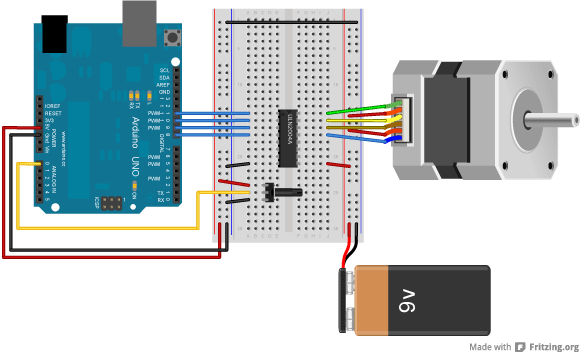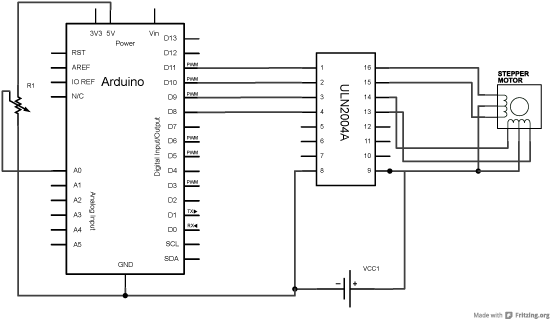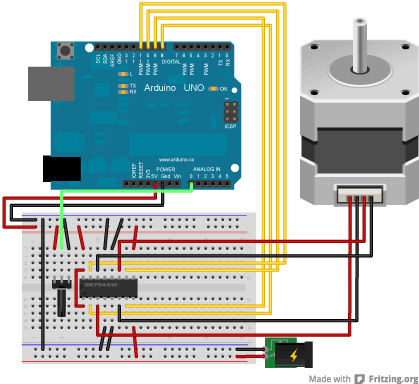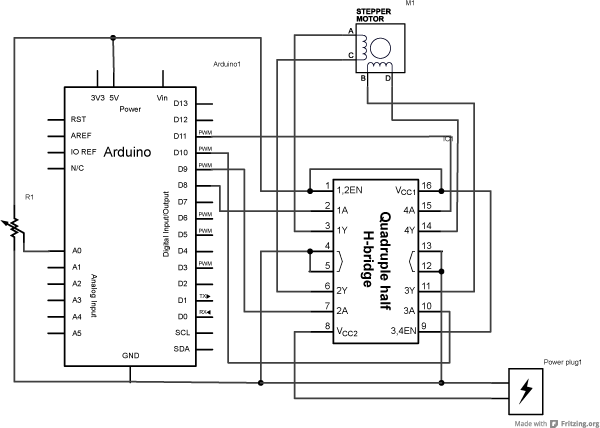Stepper Motor Knob
Stepper motors, due to their unique design, can be controlled to a high degree of accuracy without any feedback mechanisms. The shaft of a stepper, mounted with a series of magnets, is controlled by a series of electromagnetic coils that are charged positively and negatively in a specific sequence, precisely moving it forward or backward in small "steps".
There are two types of steppers, Unipolars and Bipolars, and it is very important to know which type you are working with. For each of the motors, there is a different circuit. The example code will control both kinds of motors. See the unipolar and bipolar motor schematics for information on how to wire up your motor.
In this example, a potentiometer (or other sensor) on analog input 0 is used to control the movement of a stepper motor using the Arduino Stepper Library. The stepper is controlled by with digital pins 8, 9, 10, and 11 for either unipolar or bipolar motors.
The Arduino or Genuino board will connect to a U2004 Darlington Array if you're using a unipolar stepper or a SN754410NE H-Bridge if you have a bipolar motor.
For more information about the differences of the two types, please take a look at Tom Igoe's page on stepper motors.
Hardware Required
- Arduino or Genuino Board
- 10k ohm potentiometer
- stepper motor
- U2004 Darlington Array (if using a unipolar stepper)
- SN754410ne H-Bridge (if using a bipolar stepper)
- power supply appropriate for your particular stepper
- hook-up wires
- breadboard
Circuits
Below you'll find circuits for both unipolar and bipolar steppers. In either case, it is best to power your stepper motors from an external supply, as they draw too much to be powered directly from your Arduino board.
In both circuits, connect a 10k pot to power and ground, with it's wiper outputting to analog pin 0.
Note: Both circuits below are four wire configurations. Two wire configurations will not work with the code provided.
Unipolar Stepper Circuit and schematic
|
Show images for the unipolar circuit and schematicShow images for the unipolar circuit and schematic |
Bipolar Stepper Circuit and schematic
|
Show images for the bipolar circuit and schematicShow images for the bipolar circuit and schematic |
Code
For both unipolar and bipolar steppers
* MotorKnob
*
* A stepper motor follows the turns of a potentiometer
* (or other sensor) on analog input 0.
*
* http://www.arduino.cc/en/Reference/Stepper
* This example code is in the public domain.
*/
#include <Stepper.h>
// change this to the number of steps on your motor
#define STEPS 100
// create an instance of the stepper class, specifying
// the number of steps of the motor and the pins it's
// attached to
Stepper stepper(STEPS, 8, 9, 10, 11);
// the previous reading from the analog input
int previous = 0;
void setup() {
// set the speed of the motor to 30 RPMs
stepper.setSpeed(30);
}
void loop() {
// get the sensor value
int val = analogRead(0);
// move a number of steps equal to the change in the
// sensor reading
stepper.step(val - previous);
// remember the previous value of the sensor
previous = val;
}
See also
- Stepper myStepper = Stepper(steps, pin1, pin2, pin3, pin4)
- stepper.setSpeed()
- stepper.step()
- Stepper library reference
- StepperOneRevolution - Turn the shaft one revolution clockwise and one counterclockwise.
- StepperOneStepAtATime - Single stepping to check the proper wiring of the motor.
- StepperSpeedControl - The stepping speed is controlled by a potentiometer.
Last revision 2018/08/23 by SM




